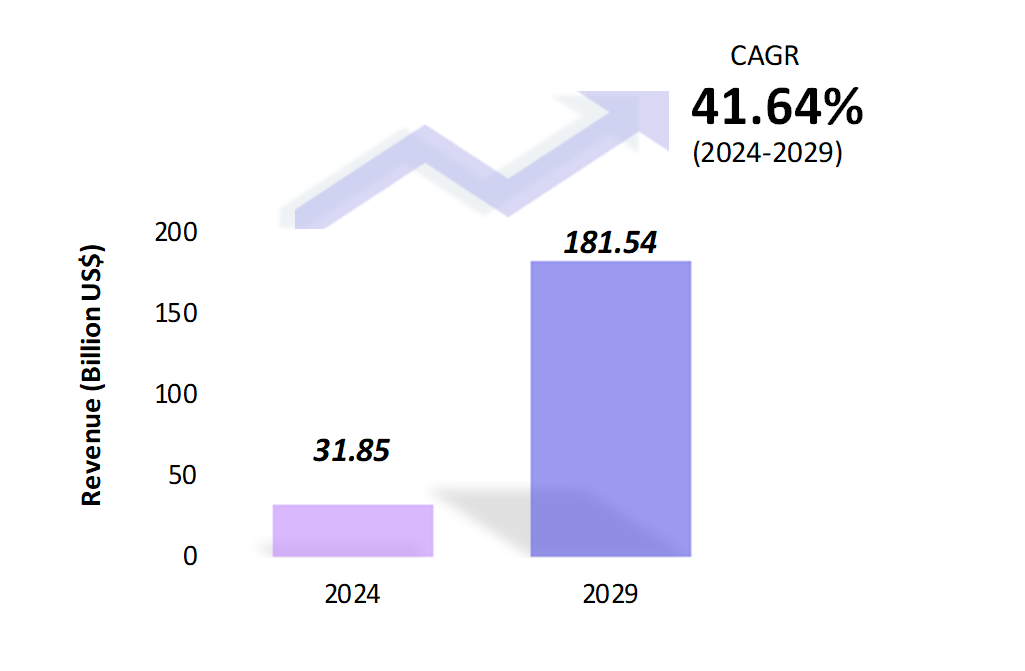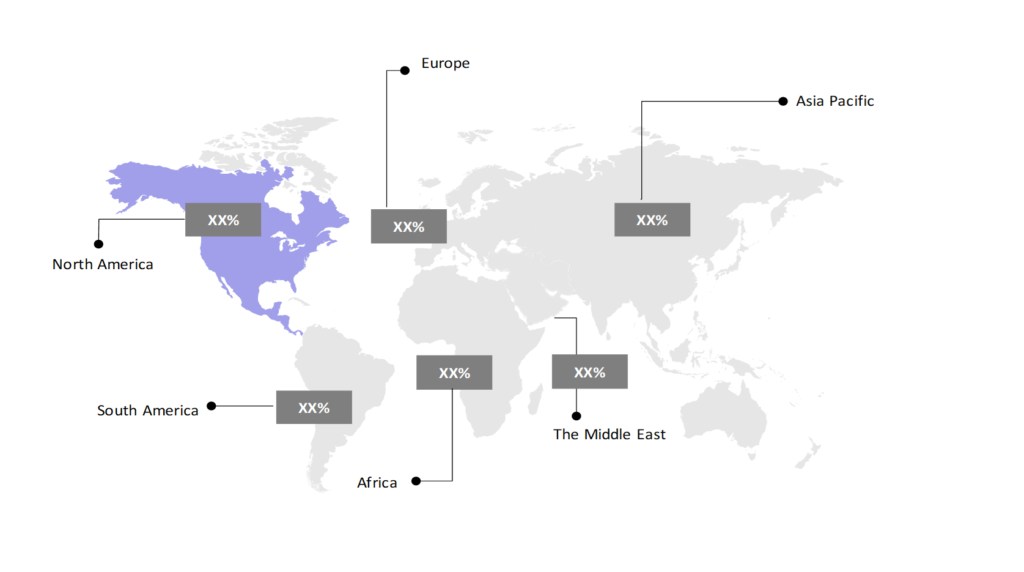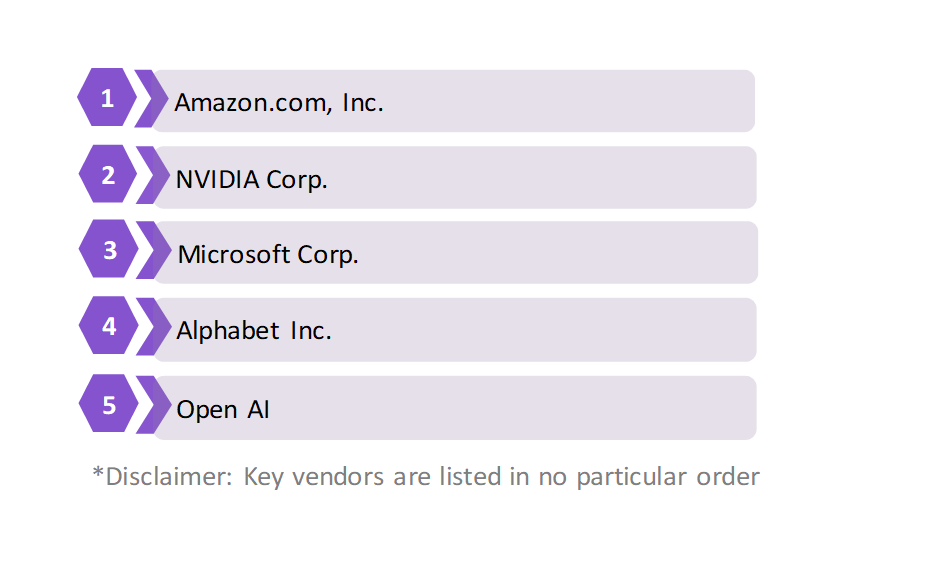Generative AI Market Analysis: Growth, Size, Share & Future Trends (2024-2029)
The report covers a comprehensive analysis segmented by Technology (Transformer, Generative Adversarial Networks (GANs), Diffusion Networks, Variational Autoencoder (VAE), Others), by End User (Media & Entertainment, Banking, Financial Services and Insurance (BFSI), IT & Telecommunication, Healthcare, Automotive & Transportation, Gaming, Others), by Geography (North America, South America, Asia Pacific, Europe, the Middle East & Africa).
Generative AI Market Snapshot

Generative AI Market Overview
The generative AI industry is projected to reach $181.54 billion in 2029 from an estimated $31.85 billion in 2024. Over the forecast period of 2024–2029, the global generative AI market is growing at a compound annual growth rate of 41.64%.
Several key factors are driving a notable increase in the generative AI market. The growing amount of data, along with the need to derive useful insights from it, has driven the need for AI-driven solutions. Generative AI algorithms have demonstrated exceptional effectiveness in analyzing intricate datasets, detecting patterns, and creating valuable predictions. Furthermore, in recent years, there has been significant growth in the IT industry, mainly because AI systems have been quickly incorporated into various sectors, increasing efficiency and flexibility.
Additionally, the increasing use of generative AI to improve chatbot conversations and boost customer satisfaction is expected to aid in market expansion. Generative AI could decrease the amount of manual work needed for tasks like order management and administrative duties, playing a vital role in driving progress in the generative AI market. It is crucial in transforming the labor force and enables businesses to improve operations, automate tasks, and make better decisions by independently creating content, models, and solutions.
Generative AI is changing the metaverse by creating lifelike virtual avatars and virtual environments, providing users with immersive experiences. Moreover, market participants are employing different tactics to enhance their services in the market and increase customer satisfaction. Factors and strategic advancements are driving the growth of the generative AI market.
Generative AI Market Coverage
| Historical & Forecast Period | 2018-2029 |
| Base Year | 2023 |
| Forecast Period | 2024-2029 |
| Units | Billion US$ |
| Segments | Technology, End User |
| Geographies | North America, South America, Asia Pacific, Europe, The Middle East, Africa |
| Key Vendors | Amazon.com, Inc., NVIDIA Corp., Microsoft Corp., Alphabet Inc., OpenAI. |
Key Geographies of Generative AI Market, 2023

Porter’s 5 Forces Analysis of Generative AI Market

Generative AI Market Trends
The growing amount of data and the necessity to derive valuable insights from it have driven the need for AI-powered solutions. Generative Artificial Intelligence algorithms have shown remarkable success in examining intricate datasets, recognizing patterns, and producing useful forecasts. Furthermore, the advancement of sophisticated generative models like DCGANs and StyleGANs has resulted in significant advancements in producing high-quality and lifelike images and videos. This shift had important consequences for sectors like entertainment, gaming, and visual content production.
Generative AI technology is becoming more widely accepted in conventional creative sectors like art and design as well as in domains like healthcare, finance, manufacturing, and cybersecurity. Hybrid methodologies that blend generative AI with other technologies, such as reinforcement learning, natural language processing, and computer vision, are becoming more popular. Regenerative AI is a growing area of study that is gaining popularity. It is a new field that is still in its initial phases of growth. There are numerous potentials uses for this technology that are very promising. The increasing demand for generative artificial intelligence applications is driven by factors such as the wider use of technologies like super-resolution, text-to-image conversion, and text-to-video conversion, as well as the growing necessity to update workflow processes in various industries.
Generative AI Market Driving Factors
The increasing need for AI-created content in different sectors has been propelling the growth of the generative AI industry. Industries like media, entertainment, gaming, and advertising require a continuous supply of new and captivating content to attract audiences and customers. Generative AI technologies provide an effective and expandable answer to this need by generating various content types such as images, videos, music, and text automatically. In the gaming sector, generative AI can create game levels, characters, and assets, lessening the workload for human designers and improving the diversity and replay value of games. Major progress in deep learning and neural networks has enhanced content generation abilities and is fueling the generative AI market.
The growing utilization of generative AI technologies for automating creative duties, producing original material, and improving user interactions. The fast-changing AI environment is also driving its expansion. It is sparking a significant change throughout the business industry. Essential functions within businesses, including marketing, sales, finance, and human resources, are key areas that can benefit from the power of new AI-powered tools. The rise of AI represents an extremely notable change, moving forward faster than any previous shifts. Although advancements like cloud computing, 5G connectivity, and the Internet of Things have brought about significant changes.
Generative AI Market Challenges
Although there are many advantages to generate AI, there are also ethical issues raised, especially in relation to the inappropriate use of AI-generated material. The capacity to produce extremely authentic deepfakes and altered media carries important consequences for spreading false information, stealing identities, and harming a person’s character or privacy. Dealing with these issues necessitates a comprehensive strategy that entails cooperation among technology creators, policymakers, and the public. Enforcing stringent rules, ethical principles, and responsible AI behaviors are crucial in reducing possible negative effects and upholding the credibility of generative AI applications.
AI models that generate content, particularly those utilizing deep learning structures, require significant computational power and resources. Organizations with limited computational resources often cannot access training and running large-scale GANs or VAEs due to the requirement of powerful GPUs or specialized hardware. Small and medium-sized businesses and individual developers may struggle with the high computational complexity due to lack of financial resources or infrastructure to invest in the necessary hardware. The absence of definite and reliable regulations can cause ambiguity for businesses in the AI system sector, hindering their ability to expand in the potential market. If a generative AI model does not cover the entirety of the target distribution and produces just a small range of results, it may result in repetitive or unrealistic samples and limit the model’s capacity to create fresh content.
Generative AI Market – Key Industry News
- In March 2024, A large language model (LLM) application Kimi chatbot, gains popularity leading to a new wave of investment and enthusiasm in the field of artificial intelligence (AI). Beijing-based start-up Moonshot AI Inc., Kimi’s developer announces its upgraded chatbot can handle up to 2 million Chinese characters in a single prompt. This causes China’s generative AI firms to rush and enter commercialization amid domestic innovation and funding frenzy.
- In March 2024, Nvidia Corp. launched more than two dozen new microservices that allow healthcare enterprises worldwide to take advantage of the latest advances in generative AI from anywhere and on any cloud. It includes optimized AI models and workflows with industry-standard APIs, or application programming interfaces, to serve as building blocks for creating and deploying cloud-native applications. It offers advanced imaging, natural language and speech recognition, and digital biology generation, prediction, and simulation.
- In March 2024, Adobe Inc. and Microsoft Corp. have partnered up to integrate Adobe Experience Cloud workflows and insights with Microsoft Copilot to bring generative AI capabilities to marketers. The collaboration is aimed to increase collaboration, efficiency, and creativity in marketing teams as they work across Adobe and Microsoft applications.
Generative AI Market Competitive Landscape
The participants in the global generative AI industry are always developing their strategies to preserve a competitive advantage. Companies primarily use acquisitions, R&D, partnerships, and technological launches. Several important entities in the generative AI market include Open AI, Microsoft Corp., Google LLC, Amazon.com, Inc., Nvidia Corp., and others. The worldwide market for generative AI is seeing sturdy growth, propelled by advancements in deep learning methods and the rising need for creativity and automation powered by AI in various sectors. Businesses are using generative AI advancements to create novel products and solutions across various fields like content creation, design, healthcare, and entertainment.
Additionally, the growth of multimodal generative models, self-supervised learning methods, and privacy-preserving techniques is driving the market to further expand. Recognizing the potential of generative AI to improve productivity, efficiency, and customer engagement, businesses are expected to keep investing in research and development to drive the global generative AI market growth soon.
Generative AI Market Company Share Analysis, 2023 (%)

Generative AI Market – Key Companies

Reason to Buy from us

Table of Contents
| 1. Introduction |
|---|
| 1.1. Research Methodology |
| 1.2. Scope of the Study |
| 2. Market Overview / Executive Summary |
| 2.1. Global Generative AI Market (2018 – 2022) |
| 2.2. Global Generative AI Market (2023 – 2029) |
| 3. Market Segmentation |
| 3.1. Global Generative AI Market by Technology |
| 3.1.1. Generative Adversarial Networks (GANs) |
| 3.1.2. Transformers |
| 3.1.3. Variational Auto-encoders |
| 3.1.4. Diffusion Networks |
| 3.1.5. Others |
| 3.2. Global Generative AI Market by End User |
| 3.2.1. Media & Entertainment |
| 3.2.2. Banking, Financial Services and Insurance (BFSI) |
| 3.2.3. IT & Telecommunication |
| 3.2.4. Healthcare |
| 3.2.5. Automotive & Transportation |
| 3.2.6. Gaming |
| 3.2.7. Others |
| 4. Regional Segmentation |
| 4.1. North America |
| 4.1.1. The U.S |
| 4.1.2. Canada |
| 4.1.3. Mexico |
| 4.2. South America |
| 4.2.1. Brazil |
| 4.2.2. Argentina |
| 4.2.3. Rest of South America |
| 4.3. Asia Pacific |
| 4.3.1. China |
| 4.3.2. India |
| 4.3.3. Japan |
| 4.3.4. South Korea |
| 4.3.5. Rest of Asia Pacific |
| 4.4. Europe |
| 4.4.1. UK |
| 4.4.2. Germany |
| 4.4.3. Italy |
| 4.4.4. France |
| 4.4.5. Spain |
| 4.4.6. Rest of Europe |
| 4.5. The Middle East |
| 4.5.1. Turkey |
| 4.5.2. UAE |
| 4.5.3. Saudi Arabia |
| 4.5.4. Rest of the Middle East |
| 4.6. Africa |
| 4.6.1. Egypt |
| 4.6.2. South Africa |
| 4.6.3. Rest of Africa |
| 5. Value Chain Analysis of the Global Generative AI Market |
| 6. Porter Five Forces Analysis |
| 6.1. Threats of New Entrants |
| 6.2. Threats of Substitutes |
| 6.3. Bargaining Power of Buyers |
| 6.4. Bargaining Power of Suppliers |
| 6.5. Competition in the Industry |
| 7. Trends, Drivers and Challenges Analysis |
| 7.1. Market Trends |
| 7.1.1. Market Trend 1 |
| 7.1.2. Market Trend 2 |
| 7.1.3. Market Trend 3 |
| 7.2. Market Drivers |
| 7.2.1. Market Driver 1 |
| 7.2.2. Market Driver 2 |
| 7.2.3. Market Driver 3 |
| 7.3. Market Challenges |
| 7.3.1. Market Challenge 1 |
| 7.3.2. Market Challenge 2 |
| 7.3.3. Market Challenge 3 |
| 8. Regulatory Landscape |
| 9. Competitive Landscape |
| 9.1. Amazon.com, Inc./td> |
| 9.2. NVIDIA Corp. |
| 9.3. Microsoft Corp. |
| 9.4. Alphabet Inc. |
| 9.5. Open AI |
| 9.6. Company 6 |
| 9.7. Company 7 |
| 9.8. Company 8 |
| 9.9. Company 9 |
| 9.10. Company 10 |
Generative AI Market – Frequently Asked Questions (FAQs)
What is the current size of the global generative AI market?
The market size for the global generative AI market in 2024 is $31.85 Bn..
Who are the major vendors in the global generative AI market?
The major vendors in the global generative AI market are Amazon.com, Inc., NVIDIA Corp., Microsoft Corp., Alphabet Inc., OpenAI.
Which segments are covered under the global generative AI market segments analysis?
This report offers in-depth insights into each technology, end user.
